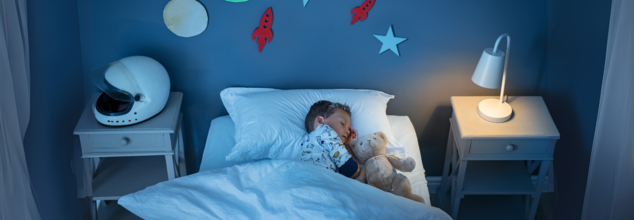
Image Credits: Canva
Sleep Training Toddlers Isn’t For The Faint Of Heart – Tips For Parents To Keep In Mind
Toddlers seem to have boundless energy; they will jump around all day long with no rest and still insist on delaying their sleep. While it may seem like they have all the energy in the world, that is not true. The only difference is that they do not know their own limits. They will eventually burn out, and it is a parent's job to make sure they are regulating their energy properly.
You must tell them when it is time to rest, when they should refuel, and how to do certain things more efficiently so that they are not spending their time and energy recklessly. One huge part of teaching them this is sleep training. Similar to how we find it difficult to do certain things when we are tired and have not slept enough, kids also have a difficult time focusing, regulating their emotions and enjoy their time with limited sleep.
Sleep Training Methods You Should Try
There are many different ways to train a toddlers, here are some methods you should try.
Fading Method
The fading method is a gentle way to help toddlers learn to sleep alone. If your child is used to being held or rocked to sleep, this method gradually reduces that. You put them in bed when they're sleepy, but still awake. If they cry, you wait a few minutes before going back in. When you do go back, offer comfort without picking them up. This helps them learn to self-soothe. Over a few nights, they'll start to fall asleep on their own, with less fussing. This method is good for toddlers who need a gradual change.
Cry It Out Method
The "cry it out" method involves putting your toddler to bed and not returning, even if they cry. Some parents find this difficult, but it can be effective. You might check in briefly to reassure them, but avoid extended comfort. This method teaches toddlers that crying won't get them out of bed. It sets clear boundaries and helps them learn to fall asleep independently. It's important to be consistent and stick to the method for it to work.
Camp It Out Method
The "camp it out" method helps toddlers transition from sleeping with parents to sleeping alone. You start by sleeping in their room, then gradually move further away. This helps them feel secure in their own bed. You can begin with a mattress on the floor, then a chair, and eventually leave the room entirely. If they wake up, you can offer brief reassurance. This method offers a gradual way to get toddlers used to sleeping alone.
Creating a Bedtime Routine for Toddler Success
Naps are important for toddlers and parents. To make nap time easier, try scheduling it at the same time every day. Plan active play before nap time to help them get tired. If your toddler sleeps well at night, they might not need naps anymore. You can replace nap time with quiet time. This allows for your child to rest, and for you to get a break as well. Consistency is key for establishing good nap habits.
A consistent bedtime routine helps toddlers know it's time to sleep. Start about 30 to 60 minutes before bed with calming activities. This could include a warm bath, reading a book, or quiet play. Avoid screens or exciting activities. Dim the lights and create a relaxing environment. The most important thing is to be consistent and do the same things every night. This helps toddlers feel secure and ready for sleep.

Image Credits: Canva
If You Have Symptoms Of 'Loose Stools, Abdomen Pain' During Pregnancy, It Might Be A Medical Emergency
Pregnancy is usually a period of euphoria and expectation, but what if the symptoms of loose stools, stomach pain, and dizziness are warning signs of something far more dangerous? Although morning sickness and fatigue are usual, these symptoms could be the sign of an ectopic pregnancy—a life-threatening condition affecting about 2% of all pregnancies. Interestingly enough, more than 90% of ectopic pregnancies are located in the fallopian tubes, where the implanted fertilized egg is found outside the uterus and can rupture, causing profuse internal bleeding. If this isn't treated, it will result in death. So how do you know when you are in danger, and what should you do if you are?
Although some aches and pains are usual, some symptoms warrant immediate medical intervention. Have you had loose stools and abdominal discomfort in early pregnancy? They may be more than just stomach upsets—they may be indicative of an ectopic pregnancy, which is a dangerous condition needing to be treated promptly.
What is Ectopic Pregnancy?
An ectopic pregnancy is one in which a fertilized egg implants outside of the uterus, usually in the fallopian tubes. These pregnancies cannot be carried to term because only the uterus can provide the necessary environment for fetal growth. Medical professionals estimate that roughly 1-2% of all pregnancies are ectopic, and more than 90% of these occur in the fallopian tubes. Less often, ectopic pregnancies may develop in the ovaries, cervix, or even the abdominal cavity.
As the pregnancy advances, the damaged tube can burst, causing extensive internal bleeding. This is a medical emergency requiring immediate surgery.
Dr. Monica Gupta, Consultant in Obstetrics and Gynecology, clarifies, "An ectopic pregnancy is a serious condition as the pregnancy cannot survive, and there is a high risk of internal bleeding, which can be fatal."
Early Symptoms of Ectopic Pregnancy
The early warning signs of an ectopic pregnancy might be subtle and confusing, simulating early signs of pregnancy, so it can be difficult to detect. Nevertheless, there are some crucial warning signs that must be evaluated immediately:
Vaginal bleeding: It can be light spotting or more significant bleeding other than a normal menstrual period.
Abdominal pain: Sustained or severe pain in the lower abdomen or pelvic region, usually on one side.
Loose stools and abdominal discomfort: Gastrointestinal disturbances, such as diarrhea and pressure in the rectum, may be a sign of a more developed ectopic pregnancy.
Dizziness and syncope: Internal bleeding causes hypotension that leads to feelings of lightheadedness or passing out.
Pain in the shoulder: This abnormal symptom might appear if blood from a ruptured ectopic pregnancy irritates the diaphragm.
Dr. Gupta points out, "Symptoms of ectopic pregnancy can be vague and difficult to differentiate from normal pregnancy, especially in early stages before tubal rupture begins." This is the reason women who have any of the aforementioned symptoms need to undergo medical examination without hesitation.
Who Is at Risk for an Ectopic Pregnancy?
Although an ectopic pregnancy can occur in any woman, there are some risk factors that can make this condition more likely:
Previous ectopic pregnancy: A history of ectopic pregnancy greatly increases the risk of recurrence.
Pelvic inflammatory disease (PID): Infection can lead to scarring of the fallopian tubes, preventing the passage of the fertilized egg.
Previous tubal surgery: Operations including tubal ligation (tying the tubes) or operations for endometriosis may predispose to it.
Use of fertility treatments: Women who have had in vitro fertilization (IVF) are at increased risk of ectopic implantation.
Smoking: Use of tobacco is associated with fallopian tube damage.
Use of IUD at conception: Though uncommon, an intrauterine device (IUD) at the time of conception may raise the risk.
Age more than 35 years: Women older than this age group have a slightly increased risk of ectopic pregnancy.
Notably, as many as 50% of ectopic pregnancies happen in women with no identifiable risk factors, which underscores the importance of caution among all pregnant women.
Why Ectopic Pregnancy Is a Medical Emergency
A growing pregnancy needs room to expand, but fallopian tubes do not have the capacity to stretch like the uterus. If an ectopic pregnancy goes undiagnosed, the tube may rupture, causing heavy internal bleeding, shock, and death if untreated.
Dr. Gupta describes, "In advanced stages, patients have severe abdominal pain, fainting, anemia, a drop in blood pressure, and shock. If rupture happens, immediate surgery is required."
How Is an Ectopic Pregnancy Diagnosed?
Early diagnosis is critical in treating an ectopic pregnancy. Physicians employ the following methods:
Pregnancy test: A positive pregnancy test with abnormal symptoms is suspicious.
Pelvic examination: Physicians can sense tenderness, a mass, or abnormal fullness in the pelvis.
Ultrasound scan: Transvaginal ultrasound can establish the lack of pregnancy in the uterus and detect its location elsewhere.
Blood tests: Testing for levels of hCG (human chorionic gonadotropin) can diagnose abnormal pregnancies.
Treatment Options for Ectopic Pregnancy
The treatment depends on the stage at which an ectopic pregnancy is diagnosed:
Medication: If caught early, methotrexate, a drug that halts cell development, can be administered to dissolve the ectopic tissue without surgery.
Surgery: In the event the condition has progressed or rupture has already happened, immediate surgery must be done to remove the pregnancy and repair or eliminate the affected fallopian tube. This is usually done laparoscopically (minimal invasive procedure).
Ectopic pregnancy is a life-threatening condition, and early diagnosis makes a big difference in outcomes. Any woman with unusual pain, bleeding, or gastrointestinal symptoms during early pregnancy must be evaluated immediately.
Dr. Gupta emphasizes, "A suspicion of ectopic pregnancy should always be made when a patient comes with abnormal bleeding or pain during early pregnancy. Delay in diagnosis can result in serious complications."
Pregnancy should be a time of joy, but unexpected complications can arise. If you are pregnant and experience persistent abdominal pain, loose stools, dizziness, or unusual bleeding, consult a healthcare provider without delay. Ectopic pregnancy is a serious but treatable condition when diagnosed early. Raising awareness and understanding the warning signs can save lives.
Dr Monica Gupta is a Consultant Obstetrics and Gynaecology at Manipal Hospital, Bhubaneshwar In India

Credits: Canva
Food Insecurity During Pregnancy Could Be Linked To Higher Health Risks
A recent study published in JAMA Network Open reveals that pregnant individuals facing food insecurity are at a higher risk of complications such as preeclampsia and gestational diabetes. The analysis, based on data from over 19,300 pregnant Kaiser Permanente Northern California members, found that those receiving food assistance did not face the same increased risks. The findings highlight the importance of food assistance programs in ensuring better maternal and infant health outcomes.
Study Reveals Link Between Food Insecurity and Pregnancy Complications
The study examined pregnant individuals who were screened for food insecurity—defined as running out of food or worrying about running out due to financial constraints. Key findings include:
- 14% (about 2,700 participants) experienced food insecurity during pregnancy.
- 7.6% (1,470 participants) received food assistance while pregnant.
- Higher rates of gestational diabetes (10.9% in food-insecure individuals vs. 7.9% in those without food insecurity).
- Increased risk of preeclampsia (8.1% vs. 6.3%).
Other complications such as preterm birth and neonatal ICU admission were also more common in food-insecure pregnancies.
No significant link was found between food insecurity and gestational hypertension or Caesarean delivery.
How Does Food Insecurity Affect Pregnancy?
Poor Nutrition and Diet Quality
Lack of access to nutritious food may lead to an unbalanced diet, increasing the risk of pregnancy-related conditions like gestational diabetes and high blood pressure disorders.
Inconsistent Eating Patterns
Skipping meals or irregular eating habits can affect blood sugar regulation and overall maternal health.
Psychological and Physical Stress
The stress of worrying about food availability can contribute to inflammation, hormonal imbalances, and other health risks during pregnancy.
Food Assistance Can Reduce Health Risks
Unlike food-insecure participants, those who received food aid did not experience the same increase in complications. This suggests that food assistance programs play a crucial role in mitigating the health effects of food insecurity.
The Special Supplemental Nutrition Program for Women, Infants, and Children (WIC) was the primary source of food assistance for study participants. In 2022, WIC provided benefits to 6.31 million pregnant and postpartum individuals, infants, and children, according to the U.S. Agriculture Department.
Recommendations: Improving Food Security in Pregnancy
Experts emphasize the need for better screening and policy improvements to address food insecurity among pregnant individuals. The study suggests:
- Routine screening for food insecurity during prenatal visits.
- Increased funding and accessibility for food assistance programs like WIC.
- Public health initiatives to ensure pregnant individuals have consistent access to nutritious food.
Food insecurity during pregnancy is linked to increased risks of gestational diabetes, preeclampsia, and other complications. However, food assistance programs can help reduce these risks, emphasizing the importance of expanding access to such resources. Ensuring that all pregnant individuals have access to adequate nutrition is essential for improving maternal and infant health outcomes.

Credits: Canva
All Thanks To Cashless Payments, Less Kids Are Now Swallowing Coins
A good news for all, especially the doctors and the kids. While the society's shift to cashless transactions has transformed everyone's day to day life. People are now able to make payments faster and no one has to worry about keeping the change. However, there's another benefit to it too. It is a health benefit! Now, there are way fewer cases of kids swallowing coins. It has reduced the need for medical procedures to remove them, reports BBC.
The study recently published in The Annals of Royal College of Surgeons of England looked at the hospital records in England over the past two decades. It also found a significant decline in procedures to remove foreign objects from children's throats, airways, and noses, with nearly 700 fewer cases by 2022.
Historically, coins had accounted for over 75% of objects that children under 6 would swallow. However, the data from the UK Payments Markets Survey show that card payments began to outpace cash in 2010. The researchers noticed the decline in the cases of kids swallowing coins during the same period. This is what suggested a link between fewer coins being in circulation and fewer accidents happening like that.
An open-access web version of the study, released in June 2024, analyzed data from 2012 to 2022. The key findings included:
- A 29% drop in foreign-body removal procedures, from 2,405 cases to 1,716
- 195 fewer procedures to remove swallowed objects, dropping from 708 to 513
- 484 fewer cases of objects being removed from noses, from 1,565 to 1,081
- 10 fewer procedures involving the respiratory tract, from 132 to 122
ENT surgeon Ram Moorthy, a member of the Royal College of Surgeons of England, praised the findings. "It is positive that fewer children are swallowing coins," he said. "This study shows how new technology can make children safer in ways we didn't intend."
What Could Have Been The Other Factors?
While the shift to cashless payment is of course a major factor in decline in such emergency cases, researchers also believe that there could be other things too that may have played role. These include:
- Childproofing the household items
- Safety campaigns that have raised awareness among parents
- An improved parental supervision which made them understand better on choking hazards
These measures have helped to reduce not just the incidents of swallowing coins, but also other objects that would often get lodged in their noses and airways.
Are There New Dangers?
While the number of cases of kids who swallowed coins may have gone down, the dangers are still there. With the growth of more and more technology, the toys are no longer simple. They run on battery and have features and elements like magnets, which are also easy for kids to swallow. In fact small button batteries can cause severe internal burns if swallowed. It can also lead to life-threatening complications within hours.
Furthermore, magnets can also be powerful neodymium magnets which can attract each other inside the body and can often pinch and damage the internal tissues.
According to NHS data from 2010 to 2016, removing foreign objects from ears and noses costs hospitals in England around £3 million per year. Children are responsible for the majority of these cases:
95% of objects removed from noses involved children
85% of objects removed from ears were from children
Among adults, cotton buds (used for ear cleaning) are the most common foreign object that requires medical removal.
© 2024 Bennett, Coleman & Company Limited

